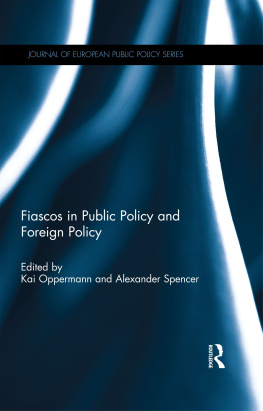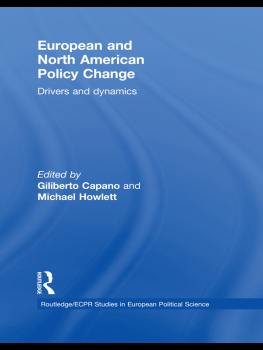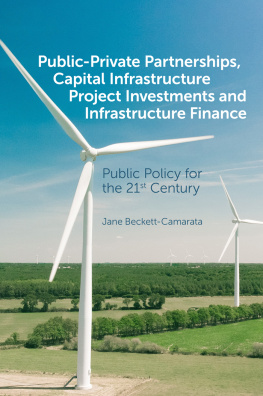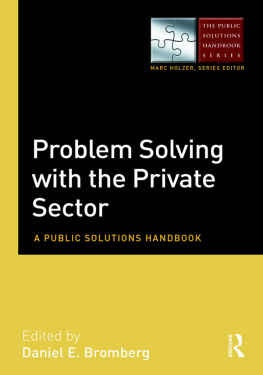POLICYMAKING FOR CRITICAL INFRASTRUCTURE
Policymaking for Critical Infrastructure
A Case Study on Strategic Interventions in Public Safety Telecommunications
GORDON A. GOW
London School of Economics and Political Science
First published 2005 by Ashgate Publishing
Reissued 2019 by Routledge
2 Park Square, Milton Park, Abingdon, Oxon, OX14 4RN
52 Vanderbilt Avenue, New York, NY 10017
Routledge is an imprint of the Taylor & Francis Group, an informa business
Copyright 2005, Gordon A. Gow
Gordon A. Gow has asserted his right under the Copyright, Designs and Patents Act, 1988, to be identified as author of this work.
All rights reserved. No part of this book may be reprinted or reproduced or utilised in any form or by any electronic, mechanical, or other means, now known or hereafter invented, including photocopying and recording, or in any information storage or retrieval system, without permission in writing from the publishers.
Notice:
Product or corporate names may be trademarks or registered trademarks, and are used only for identification and explanation without intent to infringe.
Publishers Note
The publisher has gone to great lengths to ensure the quality of this reprint but points out that some imperfections in the original copies may be apparent.
Disclaimer
The publisher has made every effort to trace copyright holders and welcomes correspondence from those they have been unable to contact.
A Library of Congress record exists under LC control number:
ISBN 13: 978-0-8153-9109-8 (hbk)
ISBN 13: 978-1-351-15160-3 (ebk)
Contents
I wish to thank Professor Robin Mansell for the kind words of encouragement that led me to pursue this book project. I am especially grateful to Peter Anderson, David Mitchell, Richard Smith and Roman Onufrijchuk for their enduring support over the years.
Preparation of the final manuscript would not have been possible without assistance from the Department of Media and Communications at the London School of Economics. Johanne Provencals copyediting has no doubt improved upon the flow and clarity of my ideas.
The case study research presented in the book was funded through programs sponsored by Public Safety and Emergency Preparedness Canada (formerly Office of Critical Infrastructure Protection and Emergency Preparedness) and the Social Sciences and Humanities Research Council of Canada.
For taking that courageous decision to join me in London, this book is dedicated to Sulya Anne.
I am, of course, responsible for reporting on and interpreting the evidence included in this study. Any errors or omissions are entirely my responsibility.
AEAA | Alberta E9-1-1 Advisory Association |
ALI | Automatic Location Identification |
ANI | Automatic Number Identification |
ANT | Actor Network Theory |
BCSPA | British Columbia 9-1-1 Service Providers Association |
CAS | Call-path Associated Signalling |
CISC | CRTC Interconnection Steering Committee |
CLEC | Competitive Local Exchange Carrier |
CRTC | Canadian Radio-television and Telecommunications Commission |
CTA | Constructive Technology Assessment |
CWTA | Canadian Wireless Telecommunications Association |
EPC | Emergency Preparedness Canada |
ESRD | Emergency Services Routing Digits |
ESWG | CISC Emergency Services Working Group |
FCC | Federal Communications Commission |
FEMA | Federal Emergency Management Agency |
ICLR | Institute for Catastrophic Loss Reduction |
ILEC | Incumbent Local Exchange Carrier |
LTS | Large Technical Systems |
MIN | Mobile Identification Number |
MSAG | Master Street Address Guide |
NCAS | Non Call-path Associated Signalling |
NENA | National Emergency Numbering Association |
OAB | Ontario 9-1-1 Advisory Board |
OCIPEP | Office of Critical Infrastructure Protection and Emergency Preparedness |
PSAP | Public Safety Answering Point |
PSEPC | Public Safety and Emergency Preparedness Canada |
PSTN | Public Switched Telephone Network |
SCOT | Social Construction of Technology |
TIF | Task Information Form |
VAS | Value-added Services |
WEWG | CWTA Wireless E9-1-1 Working Group |
WSP | Wireless Service Provider |
This book represents an effort to weave together developments in the field of disaster management with an approach known as Constructive Technology Assessment to provide a new perspective on policymaking for critical infrastructure. The essential argument that I put forward is that well-founded public policy must be based on an understanding of the social roots of risk and vulnerability in large technical systems and that this understanding must come from studying how these systems grow and change as socio-technical entities. It is precisely this knowledge that is prerequisite for the design and adoption of appropriate public policy interventions to achieve sustainable societies nationally and internationally.
The public information infrastructure plays a vital role and is at the heart of all critical systems in advanced industrial societies, and as such, it provides the central point of focus in the book. On the one hand, regulatory reform has resulted in a tremendous wave of technological innovation and ground-breaking opportunities for enhanced value-added services that could reduce risk and vulnerability by providing continuity services to a wide range of businesses and government institutions. On the other hand, such developments harbour hidden risks, particularly in light of rapid technological change and competitive pressures among service providers seeking to retain control over strategic network elements.
In many respects, this book is a product of my professional interest in an understanding of the process of growth and change in the public information infrastructure as a necessary step toward the identification and assessment of public policy intervention strategies. Originally, the project began with a general inquiry into the role of the telecommunications sector within Canadas National Disaster Mitigation Strategy, a public-private joint initiative launched in 2000/2001 and intended to reform that countrys policy framework for emergency management. At the same time, I also discovered that Canada was not alone in adopting this mitigation-oriented policy framework but that such a framework was being introduced in countries around the world, corresponding in part to the aims and spirit of the United Nations International Decade for Natural Disaster Reduction that had run from 1990 to 1999. Mitigation, it seemed to me, had emerged as the new







